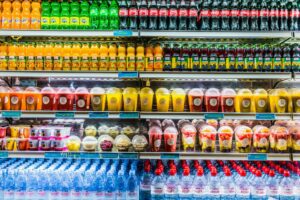Dr Paul Davidson, Challenge Director Smart Sustainable Plastic Packaging at UKRI, has written a blog on Making Plastic Packaging Sustainable as part of Recycle Week 2021.
We all rely on plastic packaging to some extent in our daily lives, but the Covid pandemic helped make us realise just how important plastic packaging is to our modern economy. As the industry contemplated the idea that illness might shut plastic production plants and so restrict the supply of plastic packaging it became obvious if we don’t have the packaging materials available then the food and goods we depend on can’t be delivered. Thankfully that didn’t happen, but it was the first time that many of us had contemplated such a scenario. Plastic packaging is essential to our economy and being light weight and highly efficient at preventing food waste is often environmentally beneficial, but it does have an issue with sustainability or to be more precise, two:
- Waste plastic entering the environment especially the marine environment
- Carbon emissions associated with the production of the plastic
The Ellen MacArthur Foundation were extremely effective in communicating the potential threat that poorly managed waste plastic poses; how many times have you heard about more plastic in the ocean than fish by 2050? Even if that figure proves to be only partially right it is still an alarming prediction. The fact that that seems plausible should be enough of a worry. They also highlighted that 32% of plastic packaging currently escapes waste management and ends up in the environment. Clearly, this cannot be allowed to continue. The UK Plastic Pact, run by WRAP, is a direct response to this and established 4 clear targets for the supply chain to meet by 2025:
- 100% of plastic packaging to be recyclable or compostable
- 70% to be effectively recycled or composted
- 30% average recycled content
- All problematic and single use plastics to be eliminated
It is our role within the Smart Sustainable Plastic Packaging challenge to support delivery of the innovation required to help meet the Pact targets. We set ourselves a strategy that followed the traditional waste hierarchy but with one key modification, we have reversed the positions of landfill and incineration for fossil based plastics, actually making landfill preferable to incineration even if the incineration is done with energy recovery. This might be counter intuitive but reflects that burning waste to generate electricity is less efficient than burning natural gas and that that the CO2 released from burning plastics is fossil derived.

Fig 1 SSPP Waste Hierarchy
Probably less well recognised is that production of polymers is also responsible for the release of carbon dioxide into the environment. Typically, each kg of plastics used in packaging produced, results in the release of 2kg of CO2. An additional 1.7kg of CO2 are emitted for every kg of plastic that ends its life in an incinerator. With the looming climate crisis, we can no longer overlook this especially if the UK is to meet its Net Zero targets.
It is crucial for the SSPP team to have an overview of the current and emerging technologies to how they relate to these two issues. Therefore, we have started trying to map them against these separate issues.

Figure 2: Sustainable Plastics Technology Landscape
Whilst this is still at a very early stage and please don’t read too much into the exact positioning, a couple of things are emerging:
- The waste hierarchy priorities waste and resources seem to hold for Net Zero at least so far
- The role of alternative feedstocks and biopolymers is very unclear and could be highly influenced by the issue of end of life options for them
As Net Zero gains more attention figuring out how exactly to decarbonise the production of plastics will be become increasingly important and in particular what role alternative, biobased feedstocks might play.
We feel the SSPP challenge is making good progress and we are looking forward to talking about some of our genuinely ground-breaking projects soon. However, we don’t for a minute underestimate the size and complexity of the challenge we have taken on and will continue to strive to be equal to it.




